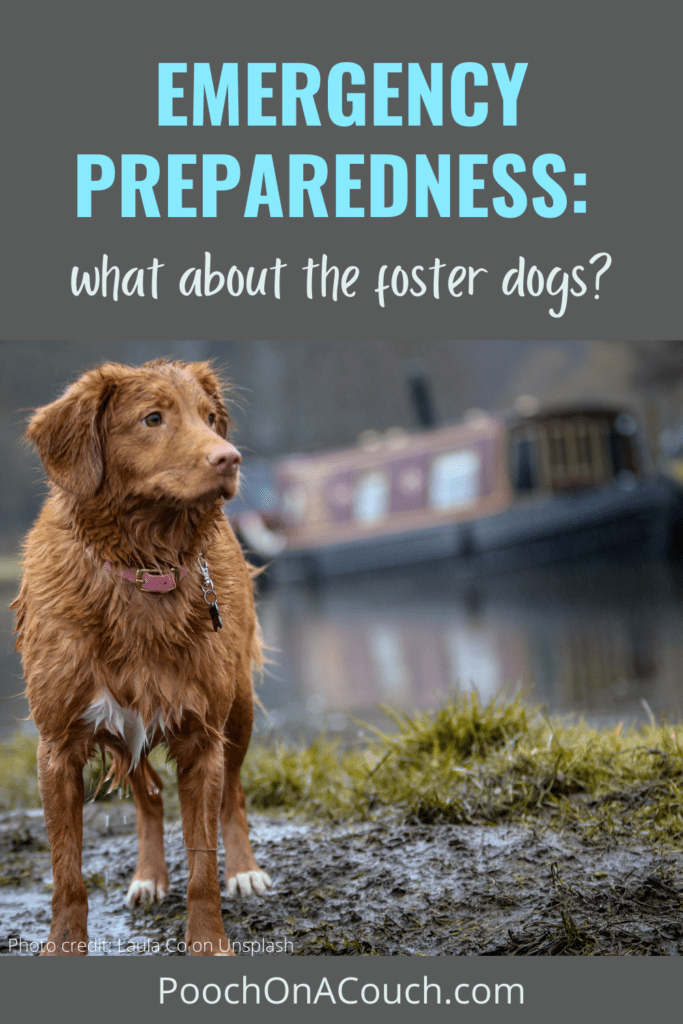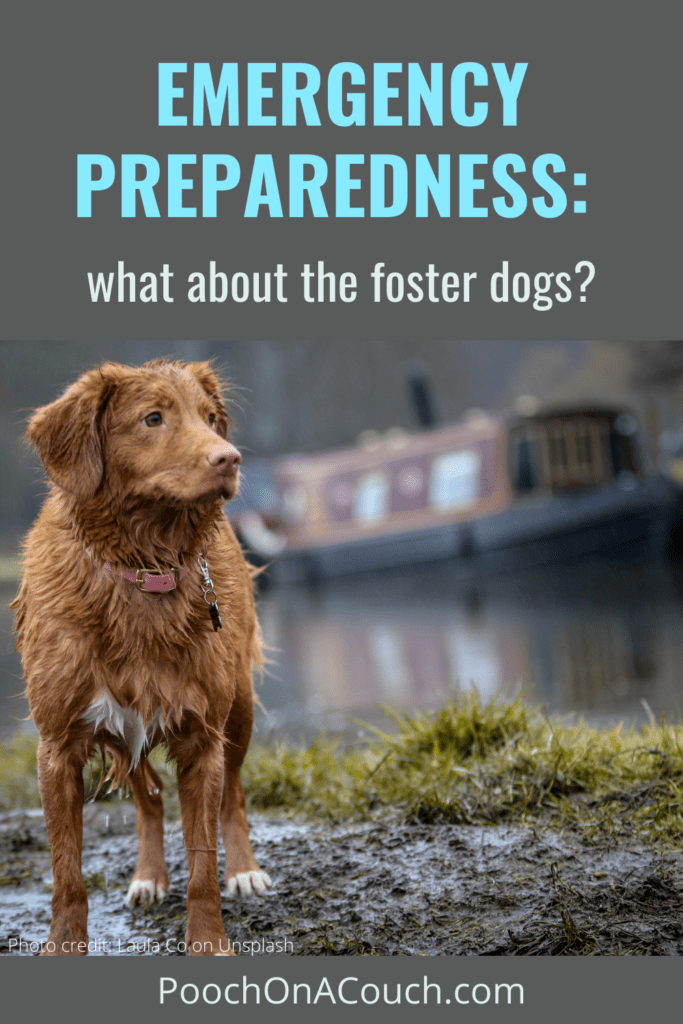Updated May 9, 2020
Hurricane season starts June 1. I know you’ve already seen the headlines: 2020 is supposed to be a doozy. Not to mention COVID-19 and what to do with your pets if you are hospitalized and the wildfires that will start soon or the flooding…….
Emergencies happen anytime, preparing for emergencies is just smart. I want you to not only have an emergency preparedness plan for yourself and your family but also for your pets and your foster dogs.
Who Is In Charge Of The Emergency Preparedness Plan For Your Foster Dogs?
What about your foster dogs? Do you have an emergency preparedness plan for them? Does your rescue organization have an emergency preparedness plan? Who’s supposed to take the lead? You or them?
In 2006, and in response to the disaster of Hurricane Katrina, Congress passed the Pets Evacuation and Transportation Standards (PETS) Act, requiring state and local governments to incorporate pets and service animals into their disaster planning.
Regarding the PETS act, you must understand this: It does not mean that you can walk up to any storm shelter or hotel and they have to, by law, take you and your pets in. They don’t. You do, however, need to know about your state and local government’s response to this Act, and what it means for you as you plan for evacuations.
So, do your homework.
What Is The Emergency Preparedness Protocol for Foster Pets?
Your rescue or shelter agency should already have an emergency preparedness protocol in place. Ask them to review it with you. Today.
Some private rescue agencies may require you to return your foster dogs to the facility for a more organized evacuation, some rescue organizations may ask you to shelter in place or evacuate with your foster dogs.
You should know ahead of time what your agency requires of you in the event of an emergency.
Be prudent and ask questions now. Whatever the emergency preparedness plan, there are steps you can take right now to get organized and prepared should you have a natural disaster or emergency and are displaced from your home.
Basic Emergency Preparedness Guidelines for Pets
Fisrt Step: Get Organized
- Decide how you are going to organize. File folders? A manila envelope for each pet? A collapsable or three ring binder? A lidded bin? Do you have a dedicated space in your house where your pet emergency kit is located? You want to be able to “grab and go”, so keep your organized documents and supplies all in one place.
- Print out pictures of your foster dogs. I’m sure you have them on your phone, but what happens if your phone battery dies and you become separated from your animals?
- Gather copies of vaccine records and most recent lab work (CBC/Chemistry panel) if you have that. I prefer you carry the rabies certificate in your folder. It is the most official document.
If you have a long-term foster dog, verify your dog is up to date on shots. I’ve seen many long-term foster dogs slip through the cracks and miss their annual check-ups. - Put ID tags on every collar! In an emergency situation, do not rely on the availablity of a microchip scanner!
Make it easy for anyone who finds your dog – have tags on your dog. This means the rabies tag and an ID tag with a contact phone number at a minimum.
In a hurry and do not have any tags? Take medical tape or masking tape, wrap it on your dog’s collar and, using a permanent marker, write a phone number on the tape. - Make sure the microchip registration is complete, accurate and up-to-date and that you have the microchip number recorded on your immunization records. If your foster dog doesn’t have a microchip, follow-up with your agency to see if this something that can be done.
- Plan for the possibility you will have a foster dog that’s on medication. Do you need a different way to organize and record medication dosing instructions? Perhaps a blank journal will be of use in a pinch. Do you need refills?
- Ya know that sticker you have on the outside of your house that alerts first responders as to how many pets are inside your home? Is that number accurate? Did you count the foster dogs? Are the foster dogs in the same room as your personal pets? A good emergency preparedness plan includes details such as these.
There’s A Disaster – Does Your Rescue Organization Know Where You Are?
- Have a conversation with your rescue administration to gather information on a plan ahead of time. If you live in a coastal area, a flood-prone area, or a wildfire-prone area, you need to know what’s expected of you. Does the rescue have a emergency plan? Will there be a point person for you to contact? Do you return the foster dog to the facility? Do they want you to respond to disasters as if the foster dog is your personal pet? Can you leave town with your foster pet?
- Consider the disposition of the pets in your home and what their needs are. Do you have a reactive foster dog that might have a come-apart in a disaster shelter? Will you need crates for your dogs or will they do fine on a leash? Problem solve these scenarios with your rescue administration ahead of time.
- Write down your plan, identify your area’s options for shelters or refuge for your foster dogs and write down the contact numbers for both shelter spaces and your rescue administration.
- Do not leave your pets behind. Don’t leave your pets, and don’t leave your foster pets – I don’t care if you asked the agency to deal with them and they can’t, don’t, or won’t. DO NOT leave your foster pets behind.
Gather Your Emergency Preparedness Supplies
Make a list of all the pet supplies you will need in the event you are in a disaster and get displaced from your home for any length of time. Things you’ll want:
- collars/harness +leash for every dog
- ID tags
- bowls
- bottled water
- medications – enough for several days – if it’s medication for a serious condition, consider having an emergency written prescription from your veterinarian on hand.
- heartworm preventive dose for each dog (you may be displaced for a while)
- an envelope, folder, or binder with your paperwork
- enough food for each dog for several days
- a favorite toy or chew for each dog
- at least one crate
- poop bags to pick up waste
- dog blankets
- first aid supplies
Even if your agency’s emergency preparedness plan is for you to hunker down and stay put, you need to make sure you have enough supplies to last until you have access to more supplies and are able to move about your community.
What’s missing? What would you include in your emergency preparedness plan? Drop us a line!
Pin Me!

More Resources:
Fema Emergency Preparedness Planning
National Safety Council Emergency Preparedness
Poison Prevention Is For Pets, Too





